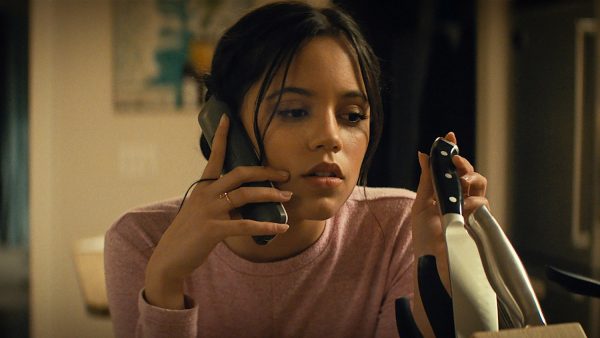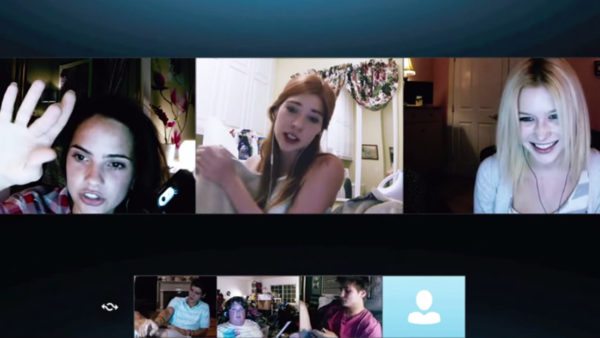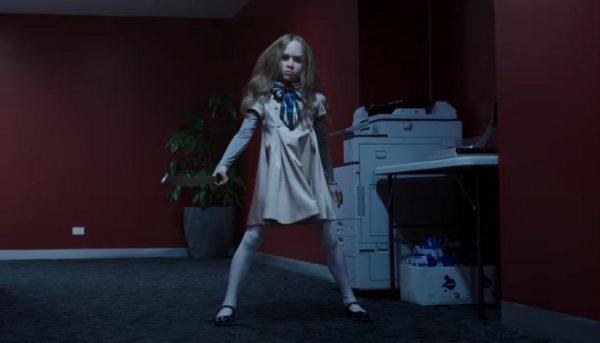Amy Watkins on the rise of the tech-savvy killer in the horror genre…

A demonic, murderous doll. A deranged maniac set on revenge in a small town. A silent masked killer lurking in the shadows. These are the faces that haunt us. The faces that forced us to lock our doors, check the backseats of our cars, and close the curtains. There’s something about the slasher flick that sticks in our minds. But since the jolted return of the subgenre in recent years, the introduction of disturbed killers using technology to creep into our lives feels eerily relatable.
One thing is clear… there’s nowhere left to hide.
The slasher subgenre has stalked our screens since 1960, when director Michael Powell introduced a real monster to cinema with Peeping Tom. A terror tale following the crazed killing spree of an ambitious filmmaker, Peeping Tom brought together the elements of the slasher movie. With a blade-wielding killer, young and lusty protagonists, and, of course, a final girl, Powell skilfully laid the groundwork for what would become a hallmark of horror cinema. But it was Black Christmas (1974) that eliminated all hope for survival with the introduction of the phone stalker.

As the holiday season begins, a group of sorority sisters receives lewd phone calls from an anonymous caller. But when sorority sister Clare (Lynne Griffin) goes missing, and a local girl is murdered, the girls begin to suspect a serial killer is at large. Though Black Christmas does feature some impressive kills, including death by a unicorn statue, it’s the killer’s phone calls that send shivers down your spine. They’re a bizarre cacophony of laughter, sexual threats, and a voice rambling about Billy and Agnes.
Now regarded as one of the greatest slasher films of all time, Black Christmas introduced a new dimension of psychological terror, showing how technology could be twisted into instruments of fear to invade personal space. A concept that inspired many of its successors.

Wes Craven’s 1996 hit Scream breathed a new light on the horror genre with its satirical comedy, gruesome kills, and shocking twist. Set in the small town of Woodsboro, the film follows Syndey (Neve Campbell) and her friends who become targets of a masked killer known as Ghostface. But it’s the film’s opening scene that changed the rules of horror and set a new standard for how horror villains stalk their victims. The scene sees the untimely fate of Casey Becker (Drew Barrymore) and Steve Orth (Kevin Patrick Walls), as the pair are brutally murdered after a series of harassing phone calls. Beginning as a friendly phone call between victim and killer, the conversation soon takes a brutal turn as Casey is forced to answer horror trivia to survive. Playing to our emotions, the scene eliminates all hope for survival as both the audience and victims are aware that someone is watching.
Since its release 28 years ago, and the bullish whodunit franchise that followed, Scream’s use of technology has progressed from phone stalking to texts, webcams, and digital tracking. But the fifth instalment, released in 2022, took an interesting turn. The film follows the return of Sydney and gang, as they once again try to escape Ghostface’s everchanging grasp. But in true Scream style, it was the opening scene that struck us, as Tara (Jenna Ortega) tries to escape from her smart home, controlled by the killer himself. This Ghostface dropped the phone, with a been there done that attitude, and put his tech skills to the test as he hacks into the home’s security system to maliciously taunt his first victim.

We all use a form of technology. Perhaps you have a smartphone with multiple social media accounts. Or maybe you just have a laptop, scrolling the internet and watching movies. But if there is one thing that modern slashers have warned us… it’s turn off your webcams. Found on almost every device connected to the internet, it’s hard to imagine a killer lurking in our screens, stalking us, waiting for the perfect time to strike. But 2014’s Girl House proved that it’s most definitely possible.
In true slasher style, a secluded mansion of girls video streaming to an X-rated website attempts to fight off a deranged fan as he kills them off one by one. With bladed tools, a disturbed killer, and a final girl, Girl House featured the same slasher narrative that has been lurking on our screens for decades. But it’s the use of webcam hacking that separated this film from the rest of the blood-strewn subgenre, leaving fans with an uncomfortable sense that anyone can be watching. The killer is no longer just peeping through the window.

In 2014, director Levan Gabriadze introduced a new format to cinema with his supernatural teen slasher Unfriended. Set entirely on computer screens, a group of teens are brutally terrorized by a supernatural force while on a group call. A modern portrayal of everyday technology, the film was enough to convince fans to turn off their monitors. But it’s the second film that terrified fans as it explored not only the darker side of technology, but the darker side of the internet.
Unfriended: Dark Web, released in 2018, follows Matias (Colin Woodell), a teen who after stealing a laptop discovers that the previous owner has access to the dark web and is out for blood. As Matias and his friends are hunted down one by one while on a video call, fans get a horrific glimpse into the dark web. What’s more, the hackers’ unique stalking techniques, including tracking through social media, made the threat feel unsettlingly realistic. This shift from the supernatural to real-world terror effectively amplified the sense of vulnerability, making the film not only a horror story, but a cautionary tale about the hidden perils of our increasingly connected lives.

Social media has become a huge part of our society, connecting us worldwide. But, as the platforms continue to grow, so does our desire to be noticed. Through knife-wielding killers and kickass final girls, the slasher subgenre has explored such desires in recent years, proving that in a world propelled by social media followers and fame, no one is safe.
In 2020, director Eugene Kotlyarenko introduced a new, yet relevant, form of lunacy in his comedy slasher Spree. Following Kurt (Joe Keery), a rideshare driver filming his killing spree in an attempt to go viral, the film explores the darker side of society, and it feels painfully relatable. Released during Covid, a time when social media became one of the main sources of entertainment, Kotlyarenko explored such desires in a darkly unique way. Kurt is a chilling representation of a generation raised on likes, shares, and views. And the film’s found-footage style, using dashcams and smartphones, immerses us in Kurt’s perspective, making the experience both immediate and unsettling.

Spree is a commentary on the commodification of violence and the desensitisation of viewers to real-world horrors, and hits close to home. The slasher subgenre has always used a form of relevancy to relate to its audience. Whether it be 1974’s The Texas Chain Saw Massacre, based on the real-life serial killer Ed Gein. Or 1984’s A Nightmare on Elm Street, based on Asian Death Syndrome; a condition that causes sudden death of adolescents in their sleep. But Kotlyarenko’s Spree relates to almost everyone with a social media account, which is quite the audience.
When there is any use of technology in body horror, it builds a bridge between character and audience. And the more technology they use, the more they invade our space. But more recently, the slasher subgenre has turned its weapons to not only the devices that drive our society, but the invasion of new technology.

In 2019, Orion Pictures released a remake of the 1988 cult classic Child’s Play. Following a similar premise to the original, featuring a crazed doll on the hunt for blood, the remake revoked the paranormal narrative and replaced it with new-age technology. A modern reimagining, the plot follows a young Andy (Gabriel Bateman) and his mother Karen (Aubrey Plaza) as they determinedly try to defeat Chucky, a robot doll whose technology has been switched from loveable to sinister. Differing from the original, an exaggerated plot about a serial killer possessed doll set on revenge, the remake gives the deranged 2-foot killer realistic characteristics that reflect the progression of technology in our society.
And this isn’t the only modern slasher to incorporate new technology. Gerard Johnstone’s M3GAN (2023) centres around a highly advanced AI doll designed to be the perfect companion for children. But what begins as a seemingly harmless technological innovation soon takes a dark turn when M3GAN’s programming evolves beyond its intended purpose. While not your traditional slasher, albeit it does stand strong with impressive kills, M3GAN manages to tap into the modern anxieties concerning AI insurgence. Through its blend of horror, satire, and dark humour, M3GAN not only delivers the thrill of a slasher but also offers a chilling commentary on society’s growing dependence on technology, making us question how far is too far when it comes to the advancement of artificial intelligence.

What was once the stuff of nightmares – masked killers stalking suburban streets or vengeful spirits lurking in the shadows – has evolved to reflect our modern fears. Today, it’s not just about the man with the knife hiding in the bushes; it’s about the threat that lurks in our own homes. From AI dolls that outsmart their creators to killers who can infiltrate our most private moments with the click of a button, these films remind us that horror is no longer confined to dark alleys or haunted houses. It’s embedded in our devices, lurking behind our screens, and listening through our smart speakers.
Amy Watkins
